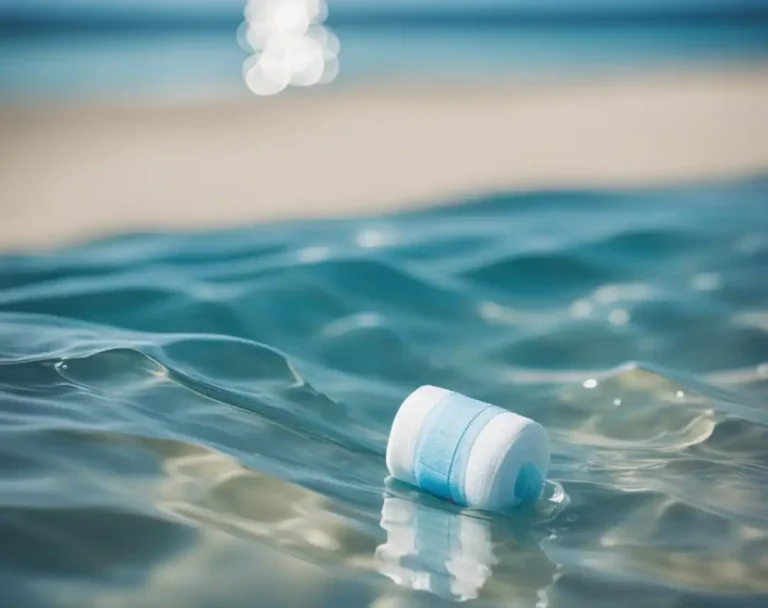To me, swimming is more than a sport or a skill; it’s a form of meditation, a dance, a way of being that transcends the ordinary. In the embrace of the water, I find peace, strength, and a deep connection to the world around me.
Swimming is my conversation with the universe, where every stroke and breath is a word spoken in the language of currents and tides. It’s where I lose myself and find myself, all in the same breath, moving through water as if through another dimension of existence.
Origins of Swimming
I’m absolutely thrilled to dive into the fascinating history of swimming! It’s as old as humanity itself. Picture this: during the Stone Age, swimming was already a part of daily life. Archaeological findings, including ancient cave paintings, suggest that our ancestors were familiar with swimming techniques.
Here’s an interesting bit: the term colymbetes was used in ancient Greece to describe swimmers. Meanwhile, epic poems like the Iliad and the Odyssey are evidence that swimming held significant value in Greek society. In these texts, heroes often demonstrated prowess in swimming.
Let’s not forget about the Romans, who were not just great engineers but also swimming enthusiasts. They built elaborate bathhouses and pools, underscoring the importance of swimming in Roman culture.
Swimming is even mentioned in historic texts such as the Bible and the heroic saga Beowulf. These references highlight that swimming is more than a sport; it has been a crucial skill throughout human history.
Ancient Egyptians also held swimming in high regard, educating their youth in the art as a fundamental component of their upbringing. It’s fascinating to see how different cultures and civilizations recognized the value of swimming across different eras!
Swimming Strokes and Techniques
When I hit the water, my focus sharpens. It’s all about the rhythm and fluidity, minimizing drag to slice through the water with efficiency. Let’s get right into the strokes that transform swimming from mere activity to an art form, starting with these classics.
Freestyle and Front Crawl
Freestyle, often synonymous with the front crawl, is the fastest stroke in swimming. It involves alternating arm movements and a flutter kick. What really revs up my speed here is the precise, alternating arm action combined with the steady flutter kicks.
- Arm Technique: Stretch arm forward, pull down through the water, and recover above water.
- Leg Technique: Continuous alternating kicks.
Backstroke
Swimming on my back, the backstroke requires supple shoulders for the arms to move in a windmill pattern. Here, the key is to keep a consistent speed:
- Arm Movement: Enter the water little-finger first, push through, and recover above.
- Kick: Similar flutter kick to freestyle, but on the back.
Breaststroke
Breaststroke is unique with its frog-like kick and simultaneous arm movements:
- Arms: Move in a heart-shaped pattern, pulling towards my chest.
- Legs: The legs perform a frog kick – bending at the knees and then snapping the legs together for propulsion.
Butterfly
Butterfly is the stroke that gets my adrenaline pumping. The simultaneous overhead arm motion and the dolphin kick are the hallmarks.
- Arm Motion: Move in a circular pattern, entering the water in front of me and pulling down.
- Dolphin Kick: Legs move together in a fluid, whip-like motion.
Individual Medley
The Individual Medley is where I showcase versatility. It’s a combination of four different strokes:
- Butterfly
- Backstroke
- Breaststroke
- Freestyle
Transitioning smoothly between these techniques is crucial to mastering the individual medley, making it a thrilling race that keeps me on my toes. Each stroke’s distinct rhythm and technique come together to create a symphony in the water.
Benefits of Swimming
Diving into my passion, I can’t help but share the wonders of swimming! This water-based exercise is not just about fun; it’s a powerhouse of health benefits that cater to everyone, from toddlers paddling in the shallow end to older adults doing laps in the pool. When I swim, I feel my muscles working harmoniously, granting a full-body workout without the harsh impact. Yes, it’s true: swimming is low-impact, making it a prime fitness choice for those with arthritis or chronic illnesses.
- Exercise: Engages multiple muscle groups.
- Health Benefits: Enhances cardiovascular health.
- Mental Health: Reduces stress, promotes well-being.
- Muscles: Tones without stress on joints.
- Low-Impact: Ideal for arthritis sufferers.
- Older Adults: Safe form of exercise to maintain fitness.
- Fitness: Boosts endurance and strength.
- Weight Loss: Burns calories efficiently.
- Chronic Illnesses: Manages symptoms, improves outcomes.
- Diabetes: Helps regulate blood sugar levels.
Every stroke I take feels like a declaration of war against calories—an effective way to lose weight while relishing the sensation of water whooshing past me. My mental health also gets a splash of positivity. Lap by lap, the stress evaporates, and a sense of tranquility takes its place. Swimming nurtures not only my body but also my soul.
For those wary of exercise-induced strain, the buoyancy of water is a gift, especially for my friends managing diabetes, as regular swims assist in regulating blood glucose levels. For me, swimming is more than an activity; it’s a jubilant journey toward enduring health and happiness.
Competitive Swimming
In the world I witness, competitive swimming is not merely a sport, it’s a thrilling spectacle where human limits are tested. Its waves ripple from local pools to the global stage, showcasing a blend of speed, skill, and stamina.
Olympic and International Competitions
The Olympics stand as the pinnacle of competitive swimming, drawing the globe’s attention every four years. The sport became a staple of the modern Olympic Games starting in Athens in 1896. Governing body FINA oversees international standards, ensuring every flip turn and freestyle stroke abides by recognized regulations. Countries from across Europe, like Hungary and Germany, regularly contribute top-tier talent to the Olympic roster.
Races and Championships
Swimming races vary in distance, stroke, and format, ranging from the explosive 50m freestyle to the enduring 1500m marathon. National Swimming Societies orchestrate championships where swimmers aggregate records, sharpen skills, and vie for medals. Events are methodically timed and swimmers are classified into age groups and skill levels to maintain fairness and competitiveness.
Records and Athletes
Competitive swimming is synonymous with world records and legendary athletes like Michael Phelps, who left an indelible mark with 23 Olympic golds. Records are meticulously logged and celebrated. Crossing the English Channel, once a dream, is now a pursued challenge by capable and determined contenders. Champions inspire awe and influence, attracting new waves of swimmers determined to leave their own strokes in the waters of history.
Swimming as Recreation and Education
Diving into the cool, shimmering water of a pool rejuvenates the soul like no other experience. It’s in that moment of immersion where recreational swimming and educational learning coalesce, transforming simple strokes into a multifaceted adventure. I’m here to guide you through this aquatic journey, where joy meets skill and safety.
Recreational Swimming
Swimming is a splash hit for all ages! From toddlers giggling in shallow kiddie pools to adults doing laps in Olympic-sized pools, it is a surefire way to bring delight. In recreational settings, swimming pools become the stage for fun activities, games, and relaxation. It’s not just about frolicking; swimming also promotes physical health, making it a favorite for fitness enthusiasts.
- Benefits of Recreational Swimming:
- Improves cardiovascular fitness
- Enhances muscle strength and flexibility
- Acts as a stress reliever
- Suitable for all age groups, including infants
Educational Programs and Lessons
The moment a child takes their first swim lesson, education makes its grand entrance. Swimming lessons are pivotal for growth, and institutions like the American Red Cross set the gold standard. Through structured lessons, swimmers from toddlers to adults learn the essentials, from basic strokes to advanced techniques.
- Swimming Lessons Structure:
- Introduction to water comfort
- Basic swimming techniques
- Stroke refinement
- Personal water safety
Life-Saving Skills and Lifeguarding
Being a lifeguard transcends the role of a poolside observer; it’s about being a lifesaver. Lifeguarding is a crucial component of swimming education, teaching essential skills in emergency prevention, response, and lifesaving techniques. The training is rigorous, ensuring each lifeguard is prepared to act swiftly and effectively in critical situations.
- Lifeguarding Essentials:
- Continuous surveillance
- Rescue and first aid proficiency
- CPR and AED operation
- Endurance and physical fitness
Swimming Gear and Apparel
Diving into the world of swimming, I’m immediately surrounded by an array of essential gear and apparel that transforms my experience in the water. The right equipment not only enhances performance but also ensures safety and comfort during my swims.
Essentials:
- Swimsuit/Swimwear: A snug fit is vital for reducing drag and allowing freedom of movement. I prefer high-quality, chlorine-resistant materials for durability.
- Goggles: Protecting my eyes from chlorine and improving underwater vision, goggles are a must. They should be fog-resistant and offer UV protection.
Additional Gear:
- Swim Caps: Less about keeping my hair dry and more about reducing resistance, swim caps also protect my hair from chlorine.
- Swim Fins: These are fantastic for building leg strength and improving my kicking technique. They come in various shapes and blade stiffness to cater to training needs.
Using the right gear effectively elevates my swimming experience. With this equipment, I’m all set for a fulfilling swim session!
Swimming in Different Cultures and Regions
I’m thrilled to dive into the vibrant patchwork of swimming across different cultures and regions. Let’s plunge into an ocean of diverse traditions and impacts, particularly looking at how swimming shapes societies in the United States and throughout Europe.
Swimming in the United States
In the United States, swimming surged in popularity by the early 20th century, leading to the formation of competitive arenas such as the NCAA championships. Synchronized swimming, developed here, showcases a blend of art and athleticism, often stirring public fascination during the Olympics. Major regions like California and Florida have fostered a beach culture where swimming is both a leisure activity and a lifeguarding necessity.
- Important Figures
- Mark Spitz: 7 gold medals in the 1972 Olympics
- Michael Phelps: The most decorated Olympian with 28 medals
European Swimming History and Impact
Europe presents a rich history, from the ancient Roman baths to the modern Olympic Games birthed in Greece. France, Great Britain, and Denmark all have storied swimming traditions contributing to the sport’s evolution. For instance, France’s national swimming federation, founded in 1920, played a pivotal role in promoting swimming as a competitive sport and as vital to physical education.
- Key Contributions
- Great Britain: Innovative swimwear technology
- Development of Swimming Societies: Encouraging mass participation
Swimming, both as an art and a sport, has established deep roots in various aspects of global culture. From the sun-kissed Australian shores to Canada’s emphasis on lifesaving skills, each region adds its stroke to the broad strokes of swimming history.
Swimming Science and Mechanics
Imagine slicing through the water like a fish, feeling an exhilarating blend of speed and resistance as my muscles work in harmony with the fluid world around me. That’s the art and science of swimming, a dance between my body and physics.
Physics in the Pool:
When I swim, I’m constantly pushing against water, experiencing a force opposite to my movement, known as drag or resistance. To increase my speed, I must refine my technique to cut through water more efficiently, reducing this resistance.
Buoyancy & Forces:
Water’s buoyancy supports my weight, allowing me to float. My body’s position, along with my limbs’ movement, generates lift and propulsive forces. For instance, when I kick, my legs act like paddles, propelling me forward. Arms pulling through water create an opposite force, further enhancing my speed.
Endurance & Therapy:
Building endurance is not just about strength; it’s about sustaining effective swimming mechanics over time. Repeated practice improves my muscle memory, promoting endurance. Interestingly, water’s resistance makes swimming a form of therapy, too, providing a low-impact environment for rehabilitation exercises.
Table of Key Concepts:
| Concept | Relevance in Swimming |
|---|---|
| Science | Study of movement and forces in water. |
| Speed | Product of efficient technique and force. |
| Resistance | Drag that opposes motion; to overcome it for speed. |
| Endurance | Ability to maintain swimming mechanics over time. |
| Buoyancy | Force that allows swimmers to float and move efficiently. |
| Therapy | Use of water’s properties for rehabilitation. |
Embracing these mechanics transforms my swim into an exciting, fluid action, harnessing water’s physics for sport, pleasure, or health.
Swimming Events and Organizations
As a passionate swimmer, I find the array of international events and organizations surrounding this sport simply exhilarating. The coordination and stature of these competitions bring together the world’s best, from the rigorous strokes in European countries to the iconic flips at the Summer Olympics. It’s a display of aquatic finesse backed by prestigious associations like the Fédération Internationale de Natation (FINA).
World Championships and FINA
The FINA World Championships are the crown jewel of competitive swimming, held biennially. Here, athletes from various nations dive into a pool of high stakes to achieve world records and personal bests. Categories span across diving, water polo, artistic swimming, open water, and swimming itself, aligning with FINA’s dedication to managing aquatic sports. Swimming, particularly, showcases a range of styles including freestyle, backstroke, breaststroke, and butterfly.
FINA, or the Amateur Swimming Association, is the global governing body responsible for the oversight of international competitions in swimming and other aquatic sports. Established in 1908, it has since expanded its reach with 209 member federations. My respect for FINA stems from their commitment to fostering swimming talents and setting up stringent world-class standards that ensure the sport’s integrity at events such as the Olympic Games, especially the Summer Olympics, drawing a global viewership that’s nothing short of mesmerizing.
Swimming and Related Activities
When I first plunged into the world of swimming, I discovered it’s much more than just propelling oneself through water. It’s a vibrant array of activities that challenge your body and enliven your spirit!
Diving
In diving, I marvel at the elegance as divers leap off springboards or platforms, executing intricate acrobatics before slicing into the water with minimal splash. Precision, grace, and daring are the hallmarks here. Judges score based on several elements, such as the approach, takeoff, execution, and entry into the water, making the sport a constant pursuit of perfection.
Water Polo
Then there’s water polo, a dynamic team sport that combines swimming prowess with ball skills akin to those found in soccer and basketball. Strategy and stamina are crucial, as I’ve observed players treading water or swimming up to three miles during a single match. Teams consist of six field players and one goalkeeper, with the goal being to outscore the opposition through tactical teamwork and raw endurance.
FAQ – Frequently Asked Questions
Why do you swim?
I swim for the clarity it brings to my mind and the joy that floods my heart with each stroke.
Can swimming really change how you feel?
Absolutely. It washes away my worries and brings me a sense of peace that I find nowhere else.
What do you think about when you’re swimming?
Sometimes everything, sometimes nothing. The water has a way of clearing my thoughts, leaving me with a profound sense of serenity.
Swimming, for me, is a soulful journey. I’m curious to know, what is swimming to you? Share your thoughts in the comments or send us a message on Instagram. Let’s dive into this beautiful conversation together.






